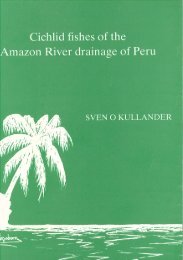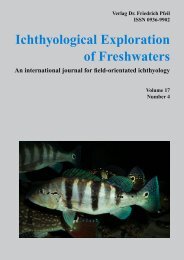Family Cichlidae (Cichlids) - Sven Kullander
Family Cichlidae (Cichlids) - Sven Kullander
Family Cichlidae (Cichlids) - Sven Kullander
Create successful ePaper yourself
Turn your PDF publications into a flip-book with our unique Google optimized e-Paper software.
Check List of the Freshwater Fishes of South and Central America<br />
Cichlasoma sanctifranciscense <strong>Kullander</strong>, 1983a: 227, pl. 12 (fig.<br />
2). Type locality: Brasil, Est. Bahia, R. São Francisco system,<br />
Lagoa Viana. Holotype: NMW 32714.<br />
Maximum length: 7.9 cm SL<br />
Distribution: South America: São Francisco River basin, also<br />
Parnaíba and Capivara River basins.<br />
Countries: Brazil<br />
‘Cichlasoma’ stenozonum Hubbs, 1936<br />
Cichlasoma urophthalmus stenozonum Hubbs, 1936: 263. Type<br />
locality: Central Amerika. Type based on description of Heros<br />
urophthalmus, Steindachner 1864: 66, p. 5 fig. 3.<br />
Maximum length: 11 cm TL<br />
Distribution: North America: Probably Atlantic slope of southern<br />
Mexico.<br />
Countries: Mexico?<br />
Remarks and references: The generic allocation of this species is<br />
still uncertain. It belongs to the tribe Heroini, but is maintained as<br />
an Incertae Sedis species of Cichlasoma pending a revision of<br />
heroin cichlids traditionally assigned to the cichlasomatin genus<br />
Cichlasoma.<br />
Cichlasoma taenia (Bennett, 1831)<br />
Chromis taenia Bennett, 1831: 112. Type locality: apud Trinidad.<br />
Holotype: BMNH 1852.9.13.123 [ex Zool. Soc.].<br />
Maximum length: 12.8 cm SL<br />
Distribution: South America: Trinidad Island, and adjacent northeastern<br />
Venezuela.<br />
Countries: Trinidad and Tobago, Venezuela<br />
Remarks and references: Redescribed by <strong>Kullander</strong> (1983a: 90)<br />
with bibliography, diagnosis, description, distribution, and illustrations.<br />
Common names: Brown coscarob (Trinidad and Tobago), Large<br />
coscarob (Trinidad and Tobago)<br />
‘Cichlasoma’ tembe Casciotta, Gómez & Toresani,<br />
1995<br />
Cichlasoma tembe Casciotta, Gómez & Toresani, 1995: 194, fig.<br />
1. Type locality: Argentina, arroyo Urugua-í, above Salto del<br />
Urugua-í, at ‘Alto Paraná’ company fields. Holotype: MLP 9059.<br />
Maximum length: 13.4 cm SL<br />
Distribution: South America: Paraná River basin, known only from<br />
the Arroyo Urugua-í, above Salto del Urugua-í, Misiones Province.<br />
Countries: Argentina<br />
Remarks and references: The generic allocation of this species is<br />
still uncertain. It belongs to the tribe Heroini, but is maintained as<br />
an Incertae Sedis species of Cichlasoma pending a revision of<br />
heroin cichlids traditionally assigned to the cichlasomatin genus<br />
Cichlasoma.<br />
‘Cichlasoma’ trimaculatum (Günther, 1867)<br />
Heros trimaculatus Günther, 1867: 602. Type locality: Chiapas<br />
and Huamuchal. Syntypes: BMNH 1864.1.26.256 (?1).<br />
Cichlasoma mojarra Meek, 1904: 217, fig. 71. Type locality: San<br />
Geronimo, Oaxaca. Holotype: FMNH 4719 [not 4718].<br />
Cichlasoma centrale Meek, 1906: 94. Type locality: Caballo<br />
Blanco, Guatemala. Holotype: FMNH 5510.<br />
Cichlasoma gordon-smithi Fowler, 1936: 529, fig. 44. Type locality:<br />
Small lake at Moco, 3050 feet elevation at foot of volcano of<br />
Atitlan. Holotype: ANSP 64153.<br />
Cichlasoma cajali Alvarez & Gutierrez, 1953: 232, fig. 1. Type<br />
locality: Laguna de Coyuca, próxima al Puerto de Acapulco, Gro.<br />
Holotype: Originally in personal collection of J. Alvarez,<br />
searched in IPN, not found.<br />
Maximum length: 36.5 cm SL<br />
Distribution: North and Central America: Pacific slope rivers of<br />
the Pacific slope from Mexico to El Salvador.<br />
Countries: El Salvador, Guatemala, Mexico<br />
Remarks and references: Heros trimaculatus is described in more<br />
detail in Günther (1868: 461, pl. 76). The generic allocation of<br />
this species is still uncertain. It belongs to the tribe Heroini, but is<br />
maintained as an Incertae Sedis species of Cichlasoma pending a<br />
revision of heroin cichlids traditionally assigned to the cichlasomatin<br />
genus Cichlasoma.<br />
‘Cichlasoma’ troschelii (Steindachner, 1867)<br />
Heros Troschelii Steindachner, 1867a: 64. Type locality: Mexico.<br />
Syntypes: (2) not found at NMW.<br />
Maximum length: 16 cm SL<br />
Distribution: North America: Probably Atlantic slope of southern<br />
Mexico.<br />
Countries: Mexico<br />
Remarks and references: Species also appeared in more detail in<br />
Steindachner (1867b: 528, pl. 4). The generic allocation of this<br />
species is still uncertain. It belongs to the tribe Heroini, but is<br />
maintained as an Incertae Sedis species of Cichlasoma pending a<br />
revision of heroin cichlids traditionally assigned to the cichlasomatin<br />
genus Cichlasoma.<br />
Common names: Guapote (El Salvador), Mojarra (El Salvador)<br />
‘Cichlasoma’ ufermanni (Allgayer, 2002)<br />
Vieja ufermanni Allgayer, 2002a: 14, fig. p. 17. Type locality:<br />
Guatemala, Rio Pucté, bassin du Rio de La Pasión, sur la route<br />
de Florès à Sayache. Holotype: MNHN 2002-1090.<br />
Maximum length: 25 cm SL<br />
Distribution: North and Central America: Atlantic slope, in the<br />
Usumacinta River basin.<br />
Countries: Guatemala, Mexico<br />
‘Cichlasoma’ urophthalmus (Günther, 1862)<br />
Heros urophthalmus Günther, 1862: 291. Type locality: Peten.<br />
Syntypes: (3) BMNH 1864.1.26.74-77.<br />
Cichlasoma urophthalmus trispilum Hubbs, 1935: 18, pl. 4 (fig. 2).<br />
Type locality: Río San Pedro de Mártir, tributary of Río Usumacinta,<br />
at El Paso de los Caballos, Department of Petén, Guatemala.<br />
Holotype: UMMZ 95520.<br />
Maximum length: 30 cm TL<br />
Distribution: North and Central America: Atlantic drainages from<br />
Mexico to Nicaragua.<br />
Countries: Belize, Guatemala, Honduras, Mexico, Nicaragua<br />
Remarks and references: The generic allocation of this species is<br />
still uncertain. It belongs to the tribe Heroini, but is maintained as<br />
an Incertae Sedis species of Cichlasoma pending a revision of<br />
heroin cichlids traditionally assigned to the cichlasomatin genus<br />
Cichlasoma.<br />
Common names: Castarrica (Mexico), Mayan cichlid (Belize)<br />
‘Cichlasoma’ zebra Hubbs, 1936<br />
Cichlasoma urophthalmus zebra Hubbs, 1936: 275, pl. 13 (fig.2).<br />
Type locality: Xlaka Cenote, about 13 km. north of Merida.<br />
Holotype: UMMZ 102123.<br />
Maximum length: 10.4 cm SL<br />
Distribution: North America: Atlantic slope, Xlaka Cenote, Merida,<br />
Yucatán, Mexico.<br />
Countries: Mexico<br />
Remarks and references: The generic allocation of this species is<br />
still uncertain. It belongs to the tribe Heroini, but is maintained as<br />
an Incertae Sedis species of Cichlasoma pending a revision of<br />
heroin cichlids traditionally assigned to the cichlasomatin genus<br />
Cichlasoma.<br />
Species inquirenda<br />
Chromys oblonga Castelnau, 1855: 14. Type locality: le Tocantins<br />
(Province de Goyaz). Holotype: MNHN A.9485. [Species similar<br />
to Cichlasoma facetum, not found since in the Tocantins River<br />
drainage].<br />
625




